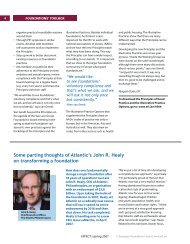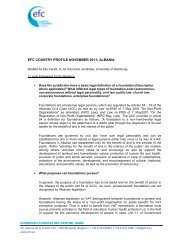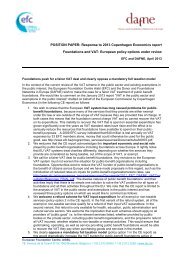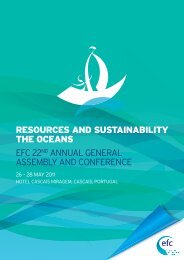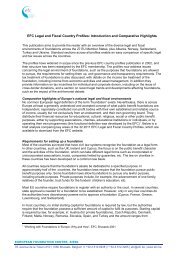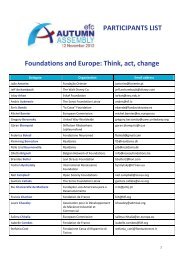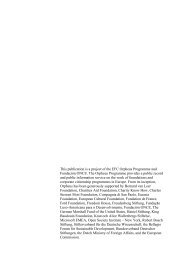Swedish foundations - The European Foundation Centre
Swedish foundations - The European Foundation Centre
Swedish foundations - The European Foundation Centre
Create successful ePaper yourself
Turn your PDF publications into a flip-book with our unique Google optimized e-Paper software.
Nordic <strong>foundations</strong>Icelanders warm toidea of philanthropyBy Jon Warne, EFCPhilanthropy is not a new concept inIceland, and up until the recent turmoilsurrounding the country’s banks – both theeconomy and charitable giving had beenfrom 2003 until 2008, Iceland’s economy(Gross Domestic Product) grew by 70%.Information on <strong>foundations</strong> based in Iceland is madeavailable via the Rikisendurskodun (Icelandic NationalAudit Office), which has monitored all registered funds andcharities since 1964. Legislation adopted in 1989 obligeseach of these organisations to send their accounts forthe previous year to the Rikisendurskodun, along with areport on how the money has been spent, and who sits onthe Board of Directors, by the end of June of each year. <strong>The</strong>Rikisendurskodun maintains a database with informationabout all income, expenditure, assets and liabilities ofregistered funds and charities.<strong>The</strong> prevailing legislation ensures the transparency of asector which, at the end of 2007, was comprised of 694registered funds and charities with combined assets tothe tune of 28.6 billion Icelandic kronas (ISK) (which at thattime was equivalent to approximately €310 million) andannual expenditure of around 8 billion ISK (then worthsome €87 million). With figures such as these, in a countrywith just over 320 000 inhabitants, Icelandic philanthropycould be said to have reached a significant scale.Although information on specific Icelandic <strong>foundations</strong>is difficult to find, it is notable that various bilateral<strong>foundations</strong> do exist. One such example is the CanadaIceland <strong>Foundation</strong>, an organisation funded by Canadiansof Icelandic descent, dedicated to the preservationof Icelandic cultural heritage. Most of these bilateralorganisations work to support the Icelandic diaspora, orenhance relations between Iceland and other countries,particularly in Scandinavia and North America.One such example is the Leifur Eiríksson <strong>Foundation</strong>, whichhas offices in the US and Iceland and operates a graduateexchange programme between the two countries. <strong>The</strong>board of trustees is appointed by the Central Bank ofIceland, the Icelandic Government, and the University ofVirginia.Greg Bocquet, “Trading Longships for Aid Packages”,<strong>The</strong> Iceland Review (Spring 2007):http://icelandreview.comIndex Mundi online database: www.indexmundi.com<strong>Swedish</strong> <strong>foundations</strong>:Evolving roles in achanging welfaresocietyBy Hanna Surmatz, EFCEach year on 10December, the wholeworld pays attention whenindividuals from all cornersof the globe are honouredfor outstanding achievementsin physics, chemistry, medicine, literatureare managed under the responsibility of thewas established in 1900 in accordance with<strong>The</strong> <strong>Swedish</strong> foundation sector, even though in most casesoperating with far less media attention, is of course much bigger.Recent research suggests a total of around 15 000 <strong>foundations</strong>in the early 21st century with combined assets worth some270 billion <strong>Swedish</strong> crowns (equivalent to approximately €24billion). <strong>Foundation</strong>s play a significant role in <strong>Swedish</strong> society,especially in the fields of science, research and culture. So itis surprising that they have not received much attention inpolitical debate or in academic research. <strong>The</strong> first thoroughanalysis of the scope, roles and vision of <strong>foundations</strong> in Swedenwas published by the Stockholm School of Economics in 2004(see Sources).According to the authors of this report, Filip Wijkström andStefan Einarsson, <strong>foundations</strong> in Sweden have assumed differentroles in different time periods: new situations leading to thecreation of <strong>foundations</strong> with new missions. At the same time,previously dominant roles and functions have not disappeared.<strong>The</strong>y either exist in parallel or have been re-interpreted ortransformed. <strong>The</strong> <strong>Swedish</strong> foundation sector is therefore moreflexible and dynamic than one might expect.A recent development in the <strong>Swedish</strong> foundation communitywas the transformation of the public wage-earner funds duringthe 1990s into private <strong>foundations</strong> supporting research. Overall,the state and local municipalities have played an important rolein creating new <strong>foundations</strong>, particularly in the last 20 yearsof the 20th century. <strong>The</strong> 2004 report mentions that parts ofsociety still look upon <strong>foundations</strong> with a degree of irritationand suspicion. One explanation for this could be that in earlierperiods <strong>foundations</strong> were established mainly by wealthyindividuals.38 | Effect spring 2009 © <strong>European</strong> <strong>Foundation</strong> <strong>Centre</strong> | | www.efc.be
Forging a stronger identityIn general, <strong>Swedish</strong> <strong>foundations</strong> are not regarded and do notnecessarily regard themselves as a distinct sector in society.Lennart Elbe of the Gustav V 90th Anniversary <strong>Foundation</strong>,for example, explicitly considers his foundation a “part ofthe non-profit youth sector”. (<strong>The</strong> foundation gives grantsto <strong>Swedish</strong> youth organisations and trains young leaders.)Dan Brändström, a board member of the recently revived<strong>Swedish</strong> network of <strong>foundations</strong>, notes that in the past many<strong>foundations</strong> did not see themselves as being part of a separatesector with a common identity, which made it more difficultfor a national association of <strong>foundations</strong> to get off the ground.Over the past 10 to 15 years, however, <strong>Swedish</strong> <strong>foundations</strong>have received more attention from politicians as well as thepublic at large, and are increasingly seen as a distinct sector.Playing complementary and innovative roles<strong>The</strong> role of <strong>Swedish</strong> <strong>foundations</strong> is often discussed inconnection with the redefinition of the scope of the modernwelfare state. Today many <strong>foundations</strong> see themselves as actorsthat complement (“fill gaps”) but do not replace the welfarestate. Metaphors used for describing this complementary roleare “oil in the machinery” or “something extra to top up with”.Representatives of two EFC members, Göran Blomqvist ofRiksbankens Jubileumsfond and Lennart Elbe of the Gustav V90th Anniversary <strong>Foundation</strong>, have stressed the complementaryand innovative roles of <strong>Swedish</strong> <strong>foundations</strong>. Blomqvist sees<strong>foundations</strong> as being free to test new ideas and act fast. In thefield of research, Riksbankens Jubileumsfond’s own analysishas, for example, shown the need to improve conditions foryounger researchers early in their academic careers, and tofund research on security policy. Blomqvist believes that,because of the welfare state, <strong>Swedish</strong> <strong>foundations</strong> may play asmaller role than their counterparts in other countries.Wijkström and Einarsson’s report identifies additional rolesplayed by <strong>Swedish</strong> <strong>foundations</strong>, and Stefan Einarsson hasidentified a number of trends during recent years:- <strong>Foundation</strong>s can be used as tools for establishing “free zones”and for opening up to alternative ideologies, methods andways of operating;- Some <strong>foundations</strong>, so-called “power <strong>foundations</strong>”, areregarded as exercising control, for example, through theownership of shares in <strong>Swedish</strong> companies.Some <strong>foundations</strong> can be seen as playing a role in developingalternative visions of society, including a more liberal visionof society. <strong>The</strong> emerging liberal vision, as well as the growthof operating <strong>foundations</strong> and the growing interest in privatedonations, constitute a wave of “new philanthropy”. Thiswould suggest that some of the newer <strong>foundations</strong> might bereplacing the state in various ways. <strong>Foundation</strong>s could be seenas an interesting but challenging vehicle for the redistributionof wealth in society.A liberal environment but few incentives<strong>The</strong> legal framework in Sweden is quite favourable and liberal,as no state approval is needed to set up a foundation. Althoughsome <strong>foundations</strong> have to register with the supervisoryauthority, registration is not a prerequisite for establishment.From a comparative perspective, the lack of fiscal incentivesfor individual and corporate donors is a disadvantage, eventhough the estimated number of <strong>foundations</strong> in Sweden ishigh (over 15 000 in a country of 9 million people). However,the tax treatment of <strong>foundations</strong> involved in business activitiesis rather liberal.<strong>Foundation</strong>s are regulated primarily by the <strong>Foundation</strong> Act,which came into force in 1996 and was last modified in 2008.<strong>The</strong>re are two main categories of <strong>foundations</strong>: grantmaking<strong>foundations</strong> whose income derives from returns on investedassets (this is the largest group); and operating <strong>foundations</strong>with some kind of project or business-related activities.Many <strong>foundations</strong> combine elements of the two categories asthey are grantmaking but also run their own projects. <strong>Swedish</strong><strong>foundations</strong> can pursue any legal purpose that the founderhas specified, but most of them (around 75%) pursue publicbenefit purposes. <strong>The</strong>ir assets must be sufficient to pursue thestated purpose for a period of at least five years.<strong>Swedish</strong> <strong>foundations</strong> are administered either by their ownboard or the board of another legal entity. <strong>The</strong>y may engagein economic activities. <strong>Foundation</strong>s can also be the majorshareholder in a company as a so-called “parent foundation”.Several <strong>Swedish</strong> <strong>foundations</strong> own companies. According toEinarsson, one of the reasons for this is that a foundation cankeep a company stable for future generations and prevent itfrom being split up.<strong>Foundation</strong>s that carry out business activities, are parent<strong>foundations</strong>, were set up with state participation and/or haveassets over a certain amount must maintain proper accountingrecords. Most of these <strong>foundations</strong> are required to prepare anannual report, which is then made public. If a foundation hasa public benefit purpose and uses its income mainly to pursuethis purpose, it can receive some tax benefits. Donations fromindividuals are not tax-deductible nor generally are donationsfrom corporations. However, companies can deduct somedonations as business expenditures if they are related to thebusiness. In the future, the <strong>Swedish</strong> foundation and associationsector may consider pushing for more tax incentives fordonors.Filip Wijkström and Stefan Einarsson, “<strong>The</strong> <strong>Swedish</strong><strong>Foundation</strong> Sector”, Stockholm School of Economics,2004Filip Wijkström and Stefan Einarsson, “<strong>Foundation</strong>s inSweden. <strong>The</strong>ir Scope, Roles & Visions”, 2004Nobel <strong>Foundation</strong>:http://nobelprize.org/nobelfoundation/index.html<strong>Swedish</strong> Network of <strong>Foundation</strong>s:www.stiftelserisamverkan.se (in <strong>Swedish</strong> only)Nordic <strong>foundations</strong>39 | Effect spring 2009 © <strong>European</strong> <strong>Foundation</strong> <strong>Centre</strong> | www.efc.be



